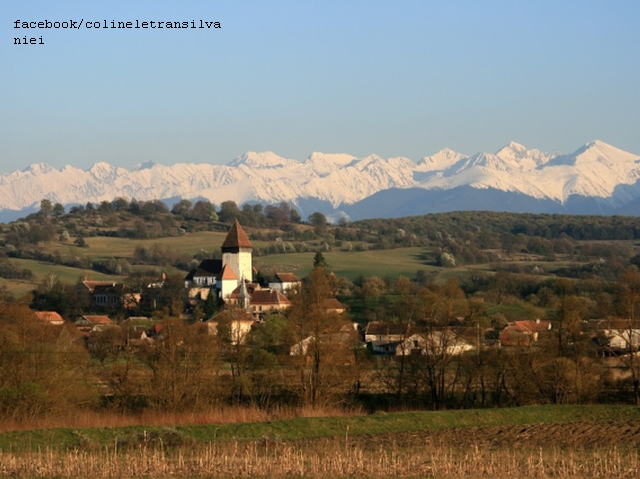Ecotourism with Transylvanian Highlands
The Transylvanian Highlands region, in the south of that province, has plenty to be proud about

Daniel Onea, 26.11.2020, 13:00
Romania has plenty of ecotourism destinations. The Transylvanian Highlands region, in the south of that province, has plenty to be proud about. On bicycle, on foot, or on horseback, you can get to know a region that sports castles, villages, and fortified churches with wonderful stories to tell. You will also enjoy local cuisine, with plenty of traditional recipes.
Cristina Iliescu, manager of the Transylvanian Highlands tourist destination, told us about this special vacation destination:
“The best known place in the Transylvanian Hills region is the area with Saxon villages. That is how people know it, the area with fortified churches. Others appreciate it as a protected area with thousands of species of birds. More recently, it was made famous by Prince Charles as his favorite place. We like it for its towns and villages that are spread around the Tarnava Mare, Hartibaciu, and the right bank of Olt River, between Sighisoara, Medias, Sibiu, Fagaras, and Rupea, right in the center of Romania. We are mostly promoters of ecotourism. We recently have applied to the ministry to get this status officially. This means cultural tourism, with care for nature, for local communities, and emphasis on nature and the link between nature and community. This mosaic of a landscape is one in which man and nature have had a strong communion along the centuries.”
We asked Cristina Iliescu what activities she proposes in such an area:
“The main thing we promote, while you trek, cycle, or horse ride, is nature watching, mainly bird watching, since this is the widest continental protected area in the country. Over here we have over 600 km worth of trails, maybe even more since they finished setting up the Terra Saxonum portion of the Via Trasilvanica. There are plenty of trails that are set up and marked for trekking, riding, or cycling. Other types of tourism are cultural tourism, rural tourism, or agro-tourism. Recently we also see gastronomical tourism. This is the birth place of the Transylvanian Brunch concept. This combines tasting local products with visits to the places that tourists came to discover.”
In an area so steeped in history and tradition, we should also talk about craftsmen and their wish to show off their skills. Here is Cristina Iliescu once again:
“One very good example to this end is the village of Malancrav. In Viscri you can also find a lot of old school crafts: brick makers, blacksmiths, or glass blowers. We have old time glass blowing workshops, with hand made glass. We also have plenty of basket weavers and fabric weavers. These are waning skills, but we also have plenty of people who want to revive them. One example would be cobblers. In Copsa Mare we have an amazing cobbler. By the same token, we have new crafts too, such as wax sculpting.”
The Transylvanian Highlands destination has a rich calendar of events. During this time of social distancing, most events that had been planned were canceled. Some of them, however, could still be held, and we found out how from Cristina Iliescu, manager of the destination:
“This is a very large area. From the perspective of the pandemic, this is a good thing. We have lots of events in villages, with only a few participants. You can take a walk through villages and literally smell the flowers while listening to classical music played live. This year we had the Sonoro concerts. Another example is the Icon Arts festival. This is a summer school for music students, and it peaks with a whole week of concerts held in the most unusual of venues, such as fortified churches. These are events that allow for social distancing, because they are outdoor events. We had large scale events planned, but they are unfeasible now. We hope by the summer next year things will get back to normal. We also have the Haferland week of bicycle races. We have a wide range of events, including theater plays.”
Most people appreciate all these offers, as we were further told:
“We have questionnaires for tourists who take up Transylvanian Highlands, to make statistics. Their reactions are mostly of amazement. They come half hearted, as if they are trying some exotic destination. Then they are amazed at the scenery, the food, the tranquility, and especially the safety. There are all sorts of wild tales circulating in Western Europe about safety in Romania, but then they tell us how safe they feel, in spite of their expectations. Ive never met a single tourist with Transylvanian Highlands who wasnt delighted with their experience.”
The program continues to grow, and will do so in years to come, as manager Cristina Iliescu told us:
“We have projects all the time. One of the ones we enjoy a lot right now is Edu Labs, by the New Horizons Foundation. This is aimed at young people who want to specialize in tourism, as guides, or story seekers. We are very happy that we manage to involve the young people in the area. We manage to involve the local community, which is very lively, and is worth promoting. You can follow all this on our website, colinele-transilvaniei.ro. We also have social media accounts under the name Transylvanian Highlands, our official name in English.”
One additional reason to seriously consider taking up the Transylvanian Highlands tour is the fact that the city of Sibiu has declared 2021 The Year of Trekking.






























